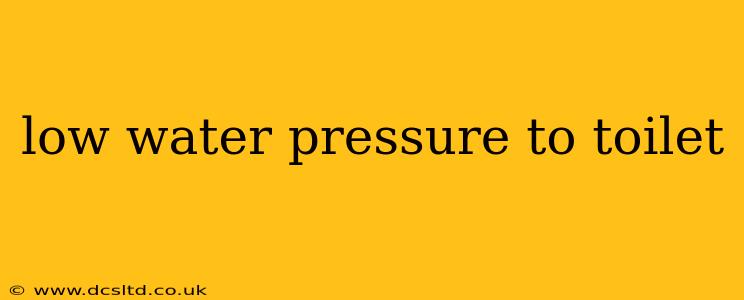Low water pressure in your toilet is a frustrating problem, often leading to weak flushes and incomplete bowl cleaning. This can range from a minor inconvenience to a significant plumbing issue. Understanding the potential causes and solutions is key to resolving the problem quickly and effectively. This comprehensive guide will walk you through the most common culprits and how to address them.
Why is my toilet's water pressure low?
This is the most common question homeowners ask when facing this issue. The answer, however, isn't always straightforward and can involve several factors. Let's explore some of the leading causes.
1. Low Water Pressure Throughout the House
The simplest explanation is often the most likely. If you're experiencing low water pressure in other fixtures, such as your shower or sink, the problem likely originates from your main water supply. This could be due to:
- Reduced City Water Pressure: Check with your local water utility company to see if there are any known issues or scheduled maintenance impacting water pressure in your area.
- Clogged Main Water Line: A blockage in your main water line restricts water flow to your entire house. This requires professional attention.
- Faulty Water Meter: A malfunctioning water meter can also restrict water flow. Contact your water utility company to have it inspected.
2. Clogged Toilet Fill Valve
The fill valve is responsible for refilling the tank after each flush. If it's clogged with mineral deposits or debris, it won't allow sufficient water to enter the tank, resulting in low pressure.
- Solution: Try cleaning the fill valve. Shut off the water supply to the toilet. Remove the tank lid and inspect the fill valve. You might find mineral deposits obstructing the water flow. Use a toilet bowl cleaner or a small brush to remove these deposits. Reassemble the valve and test the toilet. If the problem persists, replacing the fill valve might be necessary.
3. Issues with the Toilet Flush Valve
The flush valve controls the release of water from the tank to the bowl. A malfunctioning flush valve can lead to weak flushes and low pressure. This could be due to:
- Worn-out Flapper: A worn-out flapper won't seal properly, allowing water to leak continuously from the tank into the bowl. This reduces the water level in the tank, resulting in lower pressure. Replace the flapper if it's damaged or worn.
- Clogged Flush Valve: Mineral deposits or debris can also clog the flush valve, hindering the release of water. Similar to the fill valve, cleaning or replacing the flush valve might be necessary.
4. Low Water Level in the Tank
A low water level in the tank, regardless of the fill valve's functionality, directly translates to low water pressure during flushing. Several reasons may lead to this:
- Fill Valve Adjustment: The fill valve might not be adjusted correctly, preventing the tank from filling to its maximum capacity. Consult your toilet's manual for instructions on adjusting the fill valve height.
- Cracked Tank or Leaky Connections: A cracked tank or leaky connections will cause the water level to remain low even if the fill valve is working correctly. Inspect the tank carefully for cracks and ensure all connections are tight and free of leaks.
5. Clogged Toilet Bowl
While this might seem obvious, a clogged toilet bowl can significantly reduce the effectiveness of the flush, giving the illusion of low water pressure. If you're experiencing slow drainage or incomplete flushing, addressing the clog is crucial.
- Solution: Use a plunger or a toilet auger to clear the clog. If the clog persists, you may need to call a plumber.
How can I improve my toilet's water pressure?
Addressing the underlying causes discussed above is the key to improving your toilet's water pressure. If you've checked all of the above and still have low pressure, it's time to call a qualified plumber. They can diagnose more complex issues, such as problems with your main water line or internal toilet components.
Remember, preventative maintenance, such as regular cleaning of the tank and valves, can help prevent many of these issues. By understanding the potential causes and taking proactive steps, you can ensure your toilet continues to function efficiently and effectively.
